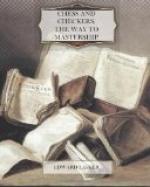Diagram 15.
White can win the game only by playing (5) K-e5. The technical term for this move is “going into opposition.” The Kings oppose each other in one line on squares of the same color and the one who has to move out of opposition—in this case Black’s King—is compelled to allow the advance of the opposing King to the next line. If Black plays K-d7, White answers (6) K-f6, and if Black plays K-f7, (6) K-d6 would follow. Then, after Black’s K-e8, White repeats the maneuver by taking the opposition with (7) K-e6, and again Black must back out with either K-d8 or K-f8, so that White can advance to either f7 or d7. This clears the way for the Pawn who now advances unimpeded to the queening square.
The important role which the opposition of the Kings play in Pawn endings is still more strikingly illustrated by the situations which would result if in the position of Diagram 15 White played (5) P-e5 instead of K-e5. Black would then draw the game by maintaining the opposition himself. He would play K-f7 and although after (6) P-e6, K-e7; (7) K-e5 White has regained the opposition he cannot keep it if Black continues correctly. The move which saves the game for Black is K-e8. K-d8 or K-f8 lose, as then White could go into opposition by K-d6 or K-f6. The play in these three cases would be this: A: (7) ..., K-e8, (8) K-f6, K-f8; (9) P-e7+, K-e8; (10) K-e6 and Black is stalemate, the game is drawn. B: (7) ..., K-d8; (8) K-d6, K-e8; (9) P-e7 and Black must move K-f7 enabling White to obtain control of the queening square by (10) K-d7. C: (7) ..., K-f8, (8) K-f6, K-e8, etc., similar to the play in B.
To sum up the investigation of this Pawn ending: The deciding factor is the opposition of the Kings on the 6th and 8th ranks. If the weaker party succeeds in obtaining that opposition with the Pawn on the 6th rank he draws the game.
If the Pawn is not yet advanced to the 6th rank the opposition of the Kings is of no avail to the weaker party as the Pawn advancing would force the opposing King out of opposition again. Suppose, for instance, White has the King on e6 and the Pawn on e5 while Black’s King stands on e8 with White on the move. White must get out of opposition by playing K-f6 or K-d6 and Black keeps the opposition by K-f8 or K-d8. But then White has a move to spare which forces Black out of opposition and thereby wins the game. He plays P-e6 and the game ends in the way discussed above.
The ending King and Pawn against King is one of the most important for every Chess player to know, not only because a great number of positions can be reduced to this ending by the exchange of all the other men left on the board, but also because it gives the first insight into the peculiar maneuvers of the King which have to be carried out in connection with gaining or giving up the opposition, and which, as will be seen later on, constitute the essence of the most frequent pawn endings.




